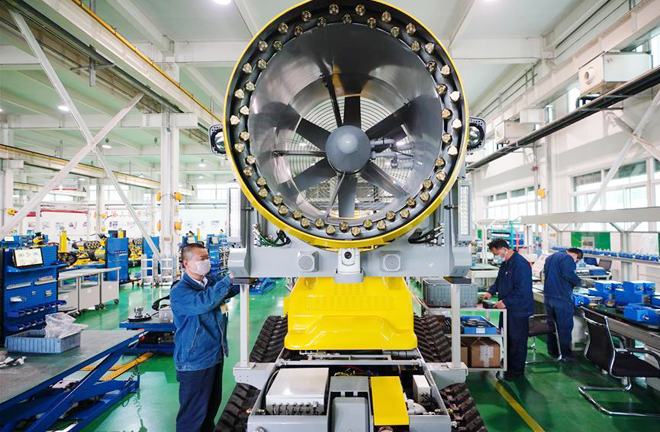Expert explores economic impact of COVID-19

Employees work at a specialized workshop producing robots at the Tangshan Hi-Tech Industrial Development Zone in Hebei Province, April 29. With strict COVID-19 prevention measures in place, high-end equipment manufacturing companies in the zone have all resumed production. Photo : Yang Shiyao/XINHUA
China’s gross domestic product stood at 20.65 trillion yuan (about 2.91 trillion US dollars) in the first quarter of 2020 with the impact of COVID-19, down 6.8% year on year, data from the National Bureau of Statistics showed in mid-April.
The main economic indicators, however, showed a rebound in March, and the decline narrowed significantly.
Huang Qunhui, director of the Institute of Economics at the Chinese Academy of Social Sciences, said that despite the fallout, China’s economy is still resilient, promising to grow by about 3% this year.
The Q1 data shows the unprecedented economic impact of COVID-19 in the short term, which far exceeds that of SARS in 2003 and the international financial crisis of 2008.
Comparing the data between March and the two previous months, however, we can see that economic indicators, such as the added value of the primary, secondary and tertiary industries, employment, investment, and consumption, have all shown a rebound in growth rate, with the rate of decline significantly or even substantially narrowed. This shows that the fallout, although strong, is short-term exogenous impact, which has exerted a greater influence on January and February. March has seen a trend of rapid recovery.
China is the world’s second largest economy with the largest total industrial production. It also has an enormous consumer market with a population of 1.4 billion and about 400 million in the middle class. For an economy of this size, despite the exogenous impact, China still has great resilience and potential, with a remarkable capacity to restore itself, Huang said. The impact of COVID-19 will not affect its steady growth momentum in the long term.
By mid-April, the resumption rate of enterprises above designated size (with annual main business revenue of 20 million yuan or more) has approached 100%. As long as political and social policies are implemented effectively, GDP growth in Q2 will return to normal, with growth in Q3 and Q4 promising to be rapid. The annual growth rate can be expected to be about 3%, Huang predicted.
The goal of economic growth can be pursued steadily and progressively only on the basis of stabilizing the people’s well-being. Huang noted that a package of fiscal and monetary policies can ensure the stability of aggregate supply and aggregate demand. In particular, bailouts and other measures can help small and medium-sized enterprises weather the storm and rise above the tide of shutdown, thereby stabilizing employment.
In addition, Huang suggested strengthening the protection of the entire industrial chain in response to the risk of interruption, as well as ensuring smooth economic operation through supply chain finance and the improvement of core enterprises’ access to information.
It is necessary to stimulate economic vitality by encouraging innovation, thereby accelerating the transition to new economic drivers, Huang said. Analysis of history often reveals that disasters, wars and sudden changes in social and economic circumstances often turn out to be opportunities to promote technological innovation, institutional innovation and management innovation.
The silver lining is that COVID-19 can promote new industries, new formats and new models, Huang said.
According to the Q1 data, in March, high-tech manufacturing witnessed a year-on-year increase of 8.9%, with computer, communications and other electronic equipment manufacturing increasing by 9.9%, industrial robotics by 12.9% and generator output by 20%. Online retail sales of physical goods rose by 5.9%.
COVID-19 has promoted both technological innovation and institutional innovation. “There is a huge space for institutional experimentation and innovation,” Huang concluded.
edited by NIU XIAOQIAN
